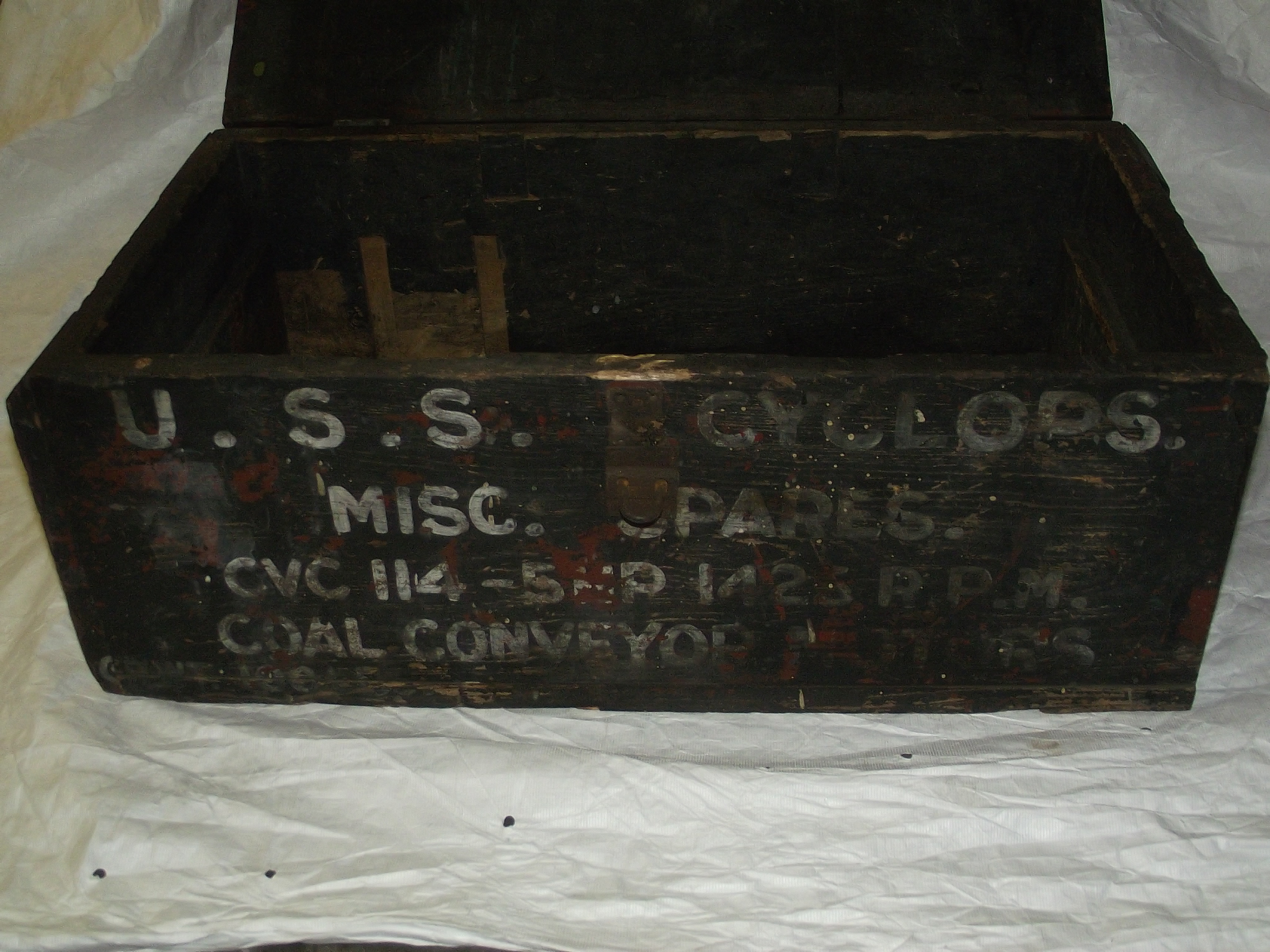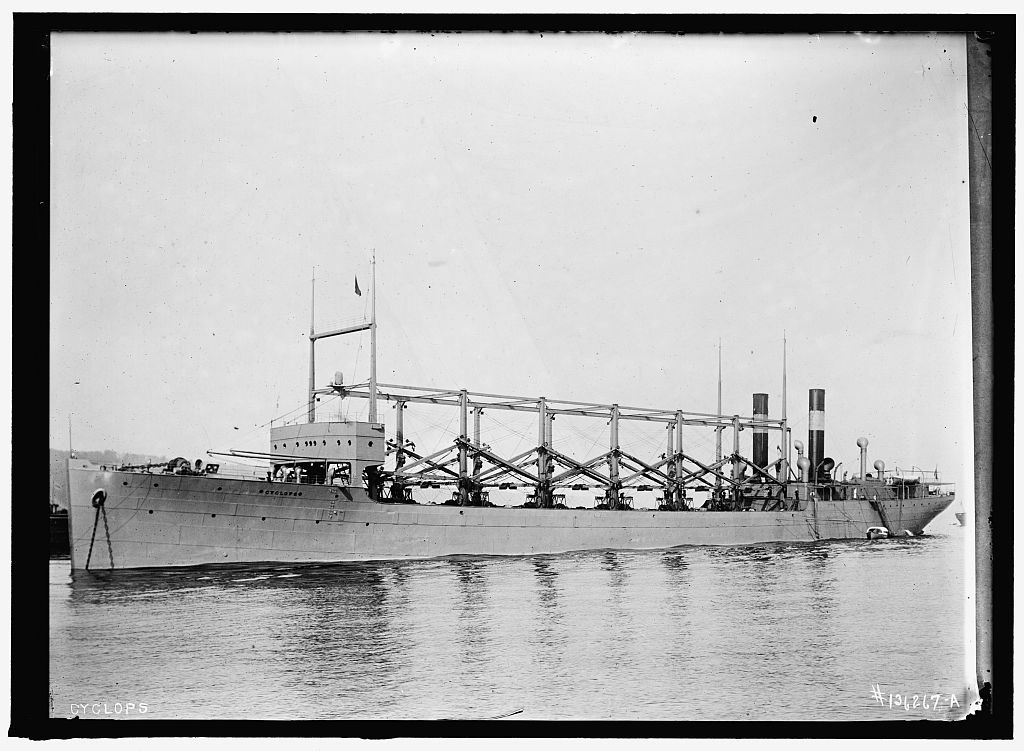One of the greatest unsolved sinking mysteries of the U.S. Navy is the story of USS Cyclops, a steel twin screw collier that went missing during World War I, rumored to have disappeared within the Bermuda Triangle. Our Artifact of the Month is actually a chest from Cyclops, which was donated to the museum in September 1941. Unfortunately, nothing was found within the sea chest, which was found under the donor’s home in Norfolk, Virginia in 1926. The box itself is marked as a spare parts box, and is made of wood with brass screws. The markings on the box state:
U.S.S. Cyclops
MISC SPARES
CVC 114-5 HP 1425 R.PM
COAL CONVEYOR MOTORS CR.WT 100LB

Cyclops was about 522 feet, with a depth of 39.5 feet so to follow battleships and provide them with the coal that they needed. Specifically, the collier was able to supply the whole fleet with fuel, providing it with anywhere from 500 to 2,000 tons of coal. This type of collier was valuable to the U.S. Navy because of its ability to meet fleets or move to avoid enemy threats, and therefore provide stability and consistency in its mobility. The collier was also a large ship, requiring 30 men and officers to manage just the ship aspect, and at least another 30 to manage the 12,000 pounds of coal it was capable of carrying. The Cyclops was built at the William Cramp & Sons Ship and Engine Building Company in Philadelphia, along with three other ships of the same design –USS Jupiter, USS Nereus and USS Proteus.
After being in use for the Naval Auxiliary Service, Atlantic Fleet in 1910, the Cyclops was commissioned for use in World War I in May 1917, under the command of Lieutenant Commander G.W. Worley. On the voyage in which it went missing, the Cyclops originally sailed to Brazil on a mission to assist the British in the south Atlantic and load up on manganese ore in Rio de Janiero. It left Rio on February 16th, 1918 for Baltimore, Maryland and was supposed to arrive on March 13th. The collier made an unscheduled stop at Barbados in early March, and then was never heard from again, taking with it a crew of 21 officers and 285 enlisted men, and some passengers. Records state that there were no recorded distress calls, and no wreckage of any sort was ever found, despite Cyclops being at almost full capacity with passengers and supplies.

Of course, there are a couple different theories as to what happened to Cyclops. There are many mixed reviews of Lieut. Commander Worley, who was originally born in Germany. Apparently he came to the United States in 1878 and changed his name from Johann Frederick Wichtmann to George Wichtmann Worley when he arrived.[1] Some stories from the boats list him as just eccentric and a German hater, while others suggest that he was completely insane and loyal to his homeland. One rumor also suggests that Worley sold his house prior to departing, implying foul play. Because of his German birth, many people believe that Worley was engaged with the German’s during World War I and either arranged for the ship to be destroyed or turned over to the Germans.
However, less romantic theories have also come to light when discussing Cyclops. There were supposedly structural issues with the ship and engine problems which led the ship to run slower than its average 14 knots. Along with poor weather, these factors could also help explain the ship’s disappearance. If Cyclops had encountered bad weather while fully loaded with structural and engine problems, the ship sinking and having its cargo scattered does not seem entirely far-fetched. This idea is supported by the fact that all three of Cyclops’ sister ships also faced problems. The Jupiter was turned into the Navy’s first air craft carrier and renamed the USS Langley, but was hit by bombs in 1942 and scuttled to avoid having the ship taken by the enemy. Even more eerie, the other two ships, named Nereus and Proteus, disappeared without a trace in the Atlantic during World War II. These stories of Cyclops’ sister ships, along with the involvement of the Bermuda Triangle, does provide a supernatural aspect to the story. It’s enough of a coincidence to make almost anyone wonder if the ships disappearance was explainable, or another creepy disappearance in the mysterious waters of the infamous Bermuda Triangle.
Adding to the mysterious nature of the story is the miscellaneous parts box that we have here at The Mariner’s Museum. With no clue as to how the box was removed from the Cyclops, or how it ended up underneath the donor’s house in Norfolk, Virginia, or why it’s completely empty, the box also adds a ghost-like aspect to the tale. However, just to add to the creepiness of the story – Lieut. Commanded G. W. Worley and his family also lived in Norfolk, Virginia. Regardless of whose it was or where it came from, the box has extraordinary provenance behind it, and is an extremely interesting aspect of our collection here at The Mariners’ Museum.
“Only God and the sea know what happened to the great ship.” – President Woodrow Wilson
[1] “Commander’s Wife Says Cyclops is Safe,” New York Times Archives, Accessed February 6, 2013. http://query.nytimes.com/mem/archive-free/pdf?res=FB0F16FC3B5F1B7A93CAA8178FD85F4C8185F9